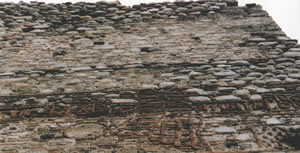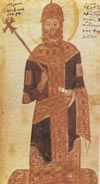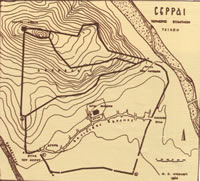THE BYZANTINE PERIOD
 |
During the early years of Byzantium, the city was part of the district of First Macedonia, and was the seat of a bishop. Maximinos (or Maximos or Maximianos), attended both the Synods of Ephesus in 449 A.D. and Chalkydona in 451 A.D. in his position as Bishop of Serres. Hieroklis listed the city among a further 32 in First Macedonia, which in turn was part of the Seventh Province of Illyria, whose capital was at Thessaloniki. The city walls were built at this time, which excluded only the city's early Christian cemetery.
 |
The absence of ancient and early-Byzantine sources is made up for by the abundance of historical records on this significant Macedonian city from mostly literary sources from the mid and late-Byzantine periods. The city was renovated in 803, during the first year of the reign of the Emperor Nikiforos, and its population increased accordingly.
 |
| Part of the eastern section of the city's Byzantine ramparts. |
The creation of the Theme of Strymona in the Ninth Century, with Serres as its capital, brought about a simultaneous increase in the city's religious importance; Serres became the seat of an archbishop, with Georgios its first archbishop. Its strategic location saw the city become a bone of contention between the Franks, the Bulgarians, the Serbs, and the Turks. In 976, Moses, the Bulgarian Voivode, was killed by a rock thrown at him from the city ramparts during his attempt to capture it. His brother Samuel's attempts to enslave the city in 980 also failed. Basil II, the Bulgar Slayer passed through the city on at least two occasions , shoring up its defences and transforming the city into a base for his operations against the Bulgarians. It was probably during his reign that the city rose in the religious hierarchy once more by becoming the seat of a Metropolitan.
 |
| The square eastern Byzantine tower. |
 |
| The helmet and inscription executed in tiles on the western side of Orestes' Tower. |
The city's location on the main route connecting Thessaloniki to Constantinople, meant it found itself in the position of having to provide supplies to the soldiers of the First Crusade who camped there in February 1097 on the orders of Bohemond, their leader. In May 1204, the city submitted to Baldwin, the Frankish emperor; while in October 1204, it became part of the Kingdom of Thessaloniki, with Boniface of Monferrat as its king. The city found itself under the jurisdiction of the Frankish Kingdom of Thrace from 1204 until the summer of 1206, when the city was totally destroyed and its fortress razed to the ground by Ioannitsi I of Bulgaria, known as Skylogiannis ("Ioannis the Dog") by the Byzantines. Boniface recaptured the city in late 1208, only to hand it over to Eric I, Emperor of Venice. Theodoros Doukas Aggelos Comnenus ejected the Latin guard to become lord of the city at the end of 1221, and Serres remained in his hands until 1230, when he was defeated by the Bulgarian Tsar, Ivan Asen II.
 |
Following the death of the twelve year old Tsar Caliman in 1245, the city became part of the Empire of Nicaea, with Ioannis III Doukas Vatatzes as its emperor, and remaining so for sixteen years. In 1261, it became a part of the Byzantine Empire once again. Things went well for the city, which became the capital of the Theme of "Serres and Strymona", under the rule of Michael VIII Palaiologos. It was under the Palaiologos family that the city enjoyed its apogee. During the lengthy dynastic struggles that followed between the grandfather and the grandson - and later Ioannis Cantacuzenus - the city of Serres was coveted by all involved because of its strategically important location.
 |
| The perimeter of the city's Byzantine fortifications (N.Nikolaou, Skapaneis tis istoriographias, Thessaloniki 1964, illus. VI) |
Stephan Dusan, the Serbian King, took advantage of the civil strife within the Byzantine Empire, and captured the city on September 25, 1345. Following Dusan's death in 1355, his son Uros ruled Serbia for five years before Eleni became Queen in 1360 with Ioannis Uglesi as emperor. Serres remained under Serbian rule until 1371. An architectural monument that has come down to us from this period is the well-known central Tower of Orestes on the acropolis.
 |
On the death of Uglesi and his brother, the Serbian state of Serres fell apart. After a brief spell under Manouil II Palaiologos, the Despot of Thessaloniki, the city was seized by the Turks on September 19, 1383.
THE PERIOD OF TURKISH RULE
 |
During the period of Turkish rule, the city of Serres belonged to the sanjak of the same name, which in turn was part of the Vilayet of Thessaloniki. Serres was the capital of its kaza (district). The area's agricultural and animal produce, coupled with its strategically vital position, helped its inhabitants to prosper. Furthermore, the weavers and goldsmiths of Serres were famed throughout the land, while the Tuesday market (the pazari) and the yearly festival, known as the "kervani", both played an important role in promoting trade in the city. Major trading houses from Europe and the Danube states established trading posts here, and the Jewish community had already made its appearance by the beginning of the Sixteenth Century.
 |
| The marble statue of E. Papa (1772-1821), the commanderin chief of the Macedonian revolutionary forces, in the city's central square. |
The local community and church seem to have been well-organised in the city. The twelve-member community committee consisted of representatives of the city guilds who were elected by the ethnic Greeks of the city. For their part, the Ottoman Turks formed the city's relatively powerful ruling elite, made up of land-owners and representatives of the state. Serres' population rose to in the region of 30,000 during the years of supremacy of Israel Bey, the city's progressive governor between 1795 and 1813. About half were Turks.
 |
The people of Serres took part in the very first rebellion against the Turks in 1571, immediately after the Battle of Lepanto. Later, they were to be initiated into the Filiki Etaireia by Ioannis Farmakis. Metropolitan Chrysanthos was the first to show his support for the organisation's ideals, but other worthies were to follow, among them Emmanouil Papas, the commander-in-chief of the Macedonian forces between 1772 and 1821, who spent his entire fortune and sacrificed his family in the struggle to free his homeland.
 |
| The marble bust of Captain Mitrousis (1882 - 1907) - a hero of Macedonian Struggle - in Euaggelistrias Square in Kato Kamenikia. |
From as early as the Seventeenth Century, Serres hummed with cultural and educational activity. The writings of Papasynadinos chronicle this century from the Greek point of view, and constitute a significant and reliable source of information. A Greek school was founded in 1735, which continued in operation until 1780. In 1834, Gregorios I Fourtouniadis, the Metropolitan of the city, was instrumental in setting up the first mutual teaching school, while the first Girls' School in the city opened its doors in 1853. And in 1872, Serres - or "the Athens of the North" as the city was now known - was the first enslaved Greek city on European soil to acquire its own Men's Teacher Training College, with the support of the Macedonian Pro-educational Association of Serres. Dimitrios Maroulis was appointed its first Head. The inhabitants of the city attended what were known as "Half High Schools" during the last years of Ottoman rule, but developments soon started coming thick and fast. A full six-year High School was opened in 1884, along with a well-stocked library; a nine-year Girls' Upper School opened its doors in 1880 (known as the Grigorias School from 1892 on); along with a four-year City School, four Primary Schools - two for boys and two for girls, and a central Nursery School. The city folk also began their struggle to found a Community Hospital very early on - in 1796 - with the active support of Metropolitan Konstantios.
 |
A part of the area burnt to the ground in the conflagration of 1913, photographed immediately after the Bulgarian withdrawal (From the collection of P.Samsaris). |
During the Macedonian Struggle, Serres was at the very centre of the Metropolitan anti-Bulgarian propaganda machine. The "Orpheas" Sports and Music Association, which was founded in 1905, also made an important contribution to the nation. The Greek Consul helped the city folk to initially defend themselves against the groups of armed Bulgarian guerrillas in the area, and later to go onto the offensive. The blood of many local men was to be spilt in the struggle. One such hero was Mitrousis Gogalakis (otherwise known as Captain Mitrousis) who barricaded himself into the bell tower of the Church of the Euaggelistria in Kato Kamenikia and resisted 3,000 Turkish soldiers for the whole of July 14 1907 before he was finally killed.The Greek-Bulgarian-Serbian Alliance was signed in 1912. However, our northern neighbours' first act of the First Balkan War against the Turks was to seize the city of Serres. Following the Greek victory, the withdrawing Bulgarian forces set fire to the city on June 28, 1913.The Greek army entered the city on June 29, 1913, thus marking the end of 530 years of bitter slavery for the long-suffering city of Serres. Rebuilding the city from the ashes must have seemed no easy task. Its inhabitants would have to face up to yet more trials and tribulations before calm once more settled over the city.
Writer:
Petros K.Samsaris